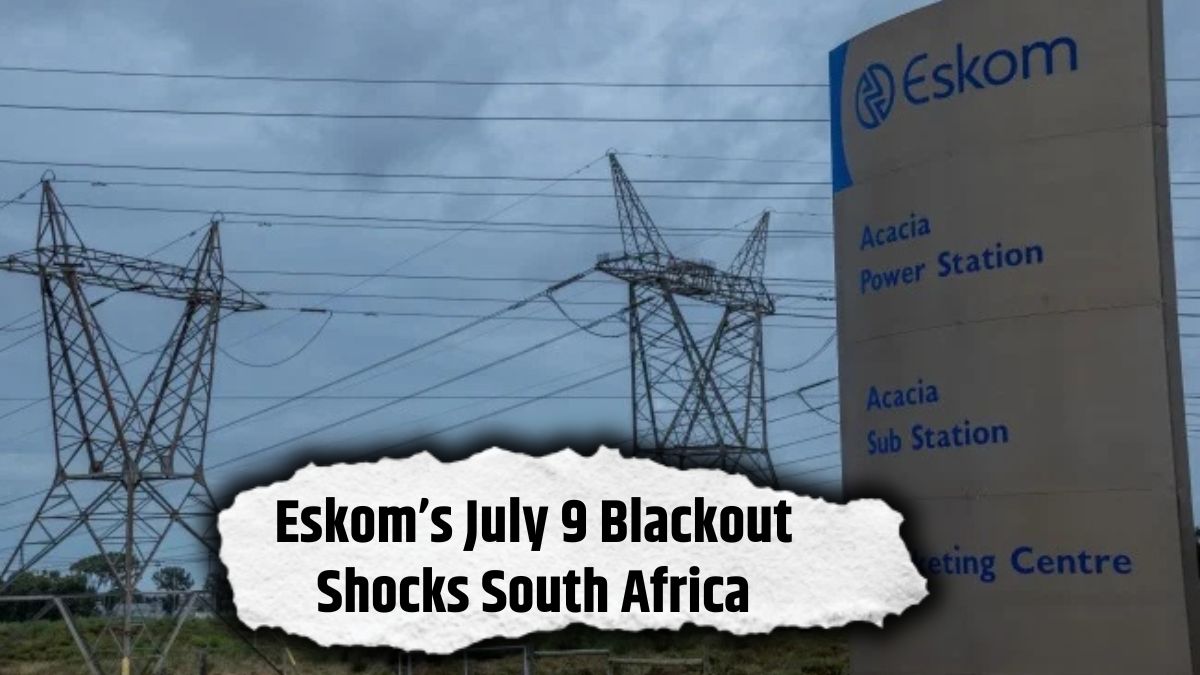South Africans woke up on July 9 to an all-too-familiar reality — yet another wave of emergency load shedding triggered by Eskom. This latest nationwide power outage affected multiple provinces, disrupting daily life, businesses, and essential services. The sudden blackout has once again raised urgent questions about Eskom’s capacity to maintain a stable power supply and the broader challenges facing South Africa’s fragile energy infrastructure.
From major metropolitan centers to rural areas, the blackout forced residents and businesses to find immediate alternatives, with many turning to generators, solar power, and community resource sharing to get through the day.
The widespread inconvenience was felt across various sectors:
- Households scrambled to adjust routines.
- Businesses experienced major operational setbacks.
- Traffic systems collapsed in several cities due to non-functional traffic lights.
- Hospitals and schools had to rely on backup power, putting strain on resources.
- Public frustration intensified, with many demanding long-term solutions instead of temporary fixes.
This outage highlighted the growing demand for alternative energy sources and public dissatisfaction with the government’s energy strategy.
Province-by-Province Impact: A Breakdown
Each province experienced unique challenges during the July 9 blackout:
| Province | Impact | Response | Key Challenges |
|---|---|---|---|
| Gauteng | Traffic gridlock | Backup generators for traffic | Increased congestion |
| Western Cape | Irrigation disruption | Switch to water-saving modes | Crop damage and financial loss |
| KwaZulu-Natal | Hospital operations affected | Emergency generators used | Risk to patient care |
| Eastern Cape | Business hours shortened | Flexible work policies | Loss in productivity |
| Limpopo | Service delivery interruptions | Community-led solutions | Limited access to power |
The blackout exposed the fragility of regional infrastructure and underscored the urgent need for localized energy planning and better coordination.
Coping Mechanisms: How South Africans Are Adapting
In the face of recurring load shedding, individuals, businesses, and communities are adapting with creative and resilient solutions:
- Solar panel installations and battery storage systems are on the rise.
- Businesses are rescheduling operations to align with load shedding schedules.
- Neighborhoods are sharing resources like generators, fuel, and lighting.
- Online platforms are being used to coordinate power usage and alerts.
While these methods offer short-term relief, the growing sentiment is clear: sustainable and long-term solutions are critical.
Long-Term Energy Crisis: What Needs to Change
The July 9 blackout is not just another Eskom issue—it’s a symptom of a broader systemic crisis in South Africa’s energy landscape. The urgent need for a diversified, resilient, and sustainable power system is becoming impossible to ignore.
Key areas of focus include:
- Expansion of renewable energy projects, especially solar and wind
- Attracting private sector investment into the energy sector
- Upgrading outdated grid infrastructure
- Implementing smart grid technology for better load management
- Enhancing consumer education around energy conservation
These initiatives could reduce Eskom’s monopoly, improve service delivery, and enhance energy security for millions of South Africans.
Government Response and Accountability
The South African government has acknowledged the crisis, promising strategic investments and reforms to stabilize the energy grid. Incentives for renewable projects, international partnerships, and legislation to diversify the energy market are among the measures being considered.
However, public trust remains low. Citizens and advocacy groups continue to call for:
- Transparent timelines and reporting from Eskom
- Public-private collaboration to fast-track infrastructure upgrades
- Emergency relief plans for vulnerable communities during outages
Without visible action and accountability, skepticism and frustration are likely to grow.
Community Resilience: A Beacon of Hope
Despite hardships, South African communities have shown remarkable resilience. From neighborhood watch groups coordinating backup energy supplies to local businesses offering mobile charging stations, the spirit of cooperation remains strong.
Examples of grassroots innovation:
- Pop-up energy hubs offering device charging and lighting
- Shared food storage facilities during outages
- Volunteer support for elderly and disabled residents
- Real-time community alert systems via WhatsApp and Telegram
These actions demonstrate that solidarity and resourcefulness are helping people navigate the ongoing crisis — even when official support is lacking.
Frequently Asked Questions (FAQs)
Q1. What caused the July 9 power outage?
The outage was a result of Eskom’s emergency load shedding, triggered by increased electricity demand and reduced generation capacity.
Q2. How are different provinces affected?
Each province faced unique challenges based on infrastructure and population density, from traffic disruptions in Gauteng to hospital strain in KwaZulu-Natal.
Q3. What is the government doing to prevent future outages?
Plans include investing in renewable energy, upgrading grid systems, and encouraging private sector involvement in power generation.
Q4. How can individuals and businesses prepare?
By investing in alternative power solutions, adjusting schedules, and conserving energy wherever possible.
Q5. Why is renewable energy so important now?
Renewable energy helps diversify power sources, reduce dependency on Eskom, and lower long-term costs and emissions.
